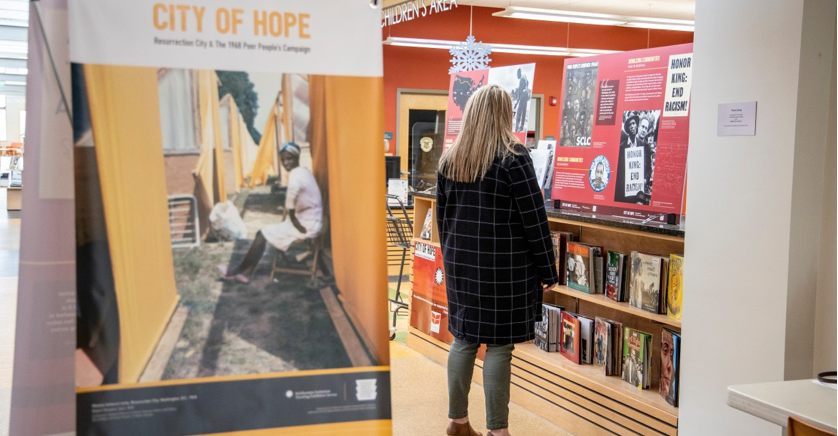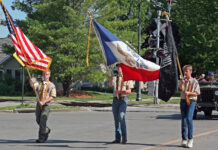The current poster exhibition displayed at the Drake Community Library from the Smithsonian honors the Rev. Martin Luther King Jr.’s final and most ambitious vision that each U.S. citizen have equal access to economic opportunities and the American dream. It showcases the Poor People’s Campaign — a grassroots, multiracial movement that drew thousands of people to Washington, D.C. For 43 days between May and June 1968, demonstrators demanded social reforms while living side by side in a tent city known as Resurrection City on the National Mall.
Organized by the Smithsonian Institution Traveling Exhibition Service (SITES) in collaboration with the National Museum of African American History and Culture, “City of Hope” highlights a series of newly discovered photographs and an array of protest signs and political buttons collected during the campaign.
Featuring seven banners and two posters, the exhibition will help visitors engage and contextualize the campaign’s historical significance and present-day relevance. Although President Lyndon B. Johnson declared a “war on poverty” in 1964, tens of millions of Americans were denied livable wages, adequate housing, nutritious food, quality education, and health care.
Led by King and the Rev. Ralph David Abernathy, the Southern Christian Leadership Conference (SCLC) organized the Poor People’s Campaign to bring a focus on poverty as a national human rights issue. Stretching 16 acres along the National Mall between the Lincoln Memorial and the Washington Monument, Resurrection City housed 3,000 protesters in a tent city with additional structures for essential services like sanitation, communications, medical care and child care. It included a dining tent, cultural center and a city hall along the encampment’s bustling “Main Street.”
The Poor People’s Campaign marked an important moment in U.S. history and set the stage for future social justice movements. Within months after Resurrection City’s evacuation, policies were advanced toward economic equality such as school lunch programs, rent subsidies and home ownership assistance for low-income families, education and welfare services through the Bureau of Indian Affairs, and more.
“We are excited to share the histories found in the Smithsonian at the Drake Community Library,” states Sarah Smith, Director of Outreach Programs and Events in the Office of Community Partnerships, Planning and Research at Grinnell College. “Many thanks to the Drake Community Library for hosting this exhibition and to Grinnell College Museum of Art and the Grinnell Public Humanities Partnership for the wonderful programming that was developed around the content of this exhibition.”
In addition to organizing the poster exhibition, Morgan Niner, an AmeriCorps VISTA member, created a tent city craft for all ages. “We wanted to have interactive elements that connected to events of the Poor People’s Campaign of 1968 at the library. We also partnered with the Grinnell College Museum of Art (GCMoA) to share resources from their collection that pertained to the exhibition and Black History Month,” said Niner.
Visitors to the Drake Community Library will find several activity guides, prints of John Phillips’ photos, coloring pages and a sheet of QR codes linking to portfolios of works in the Museum of Art, organized around Black history and civil rights topics.
Reprinted from the Grinnell College website; https://www.grinnell.edu/news/grinnell-college-presents-smithsonian-poster-exhibition-city-hope-resurrection-city-and-1968





